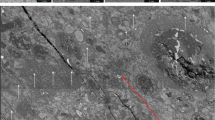Abstract
The loose material—regolith—on the surfaces of asteroids is thought to represent ballistically emplaced ejecta from impacts1,2 but the identification of source craters and the detailed study of the regolith modification have been hampered by the limited spatial resolution and area coverage of the few asteroids imaged by spacecraft. Here we report the results of global mapping of the asteroid 433 Eros from high-resolution images obtained by the NEAR-Shoemaker spacecraft. Based on the images and ejecta-emplacement models, we suggest that most large ejecta blocks on Eros originate from a relatively young 7.6-km-diameter crater. A large fraction of the ejecta from impacts pre-dating that crater has apparently been buried or eroded. The images also show evidence for the action of a variety of sorting environments for regolith particles after they are deposited on the surface.



Similar content being viewed by others
References
Housen, K. R., Wilkening, L. L., Chapman, C. R. & Greenberg, R. Asteroidal regoliths. Icarus 39, 317–351 (1979).
Geissler, P. et al. Erosion and ejecta reaccretion on 243 Ida and its moon. Icarus 120, 140–157 (1996).
Thomas, P. C. Ejecta emplacement on the martian satellites. Icarus 131, 78–106 (1998).
Thomas, P. C. et al. Eros: Shape, slopes, and slope processes. Bull. Am. Astron. Soc. 32, 994 (2000).
Veverka, J. et al. The landing of the NEAR-Shoemaker spacecraft on asteroid 433 Eros. Nature 413, 390–393 (2001).
Cintala, M. J., Garvin, J. B. & Wetzel, S. J. The distribution of blocks around a fresh lunar mare crater. Proc. Lunar Planet. Sci. Conf. 13, 100–101 (1982).
Asphaug, E. & Melosh, H. J. The Stickney impact of Phobos: A dynamical model. Icarus 101, 144–164 (1993).
Moore, H. H. in Analysis of Apollo 10 Photography and Visual Observations 26–27 NASA SP-232 (NASA, Washington DC, 1971).
Lee, S. W., Thomas, P. & Veverka, J. Phobos, Deimos, and the Moon: Size and distribution of crater ejecta blocks. Icarus 68, 77–86 (1986).
Lee, P. C. et al. Ejecta blocks on 243 Ida and on other asteroids. Icarus 120, 87–105 (1996).
Hartmann, W. K. Terrestrial, lunar, and interplanetary rock fragmentation. Icarus 10, 201–213 (1969).
Shoemaker, E. M. et al. Television observations from Surveyor V. JPL-NASA Technical Report 32-1246 (NASA, Washington DC, 1967).
Meloy, T. & O'Keefe, J. A. Size distribution of lunar surface materials. J. Geophys. Res. 73, 2299–2308 (1968).
Cintala, M. J. & McBride, K. M. Block distributions on the lunar surface: A comparison between measurements obtained from surface and orbital photography. NASA Technical Memorandum 104804 (NASA, Washington DC, 1995).
Thomas, P. C. et al. Phobos: regolith and ejecta blocks investigated with Mars Orbiter Camera images. J. Geophys. Res. 105, 15091–15106 (2000).
Horstmann, K. C. & Melosh, H. J. Drainage pits in cohesionless materials: Implications for the surface of Phobos. J. Geophys. Res. 94, 12433–12441 (1989).
Duennebier, F. K. & Sutton, G. H. Thermal moonquakes. J. Geophys. Res. 79, 4351–4363 (1974).
Lee, P. C. Dust levitation on asteroids. Icarus 124, 181–194 (1996).
Robinson, M. S., Thomas, P. C., Veverka, J., Murchie, S. & Carcich, B. The nature of ponded deposits on Eros. Nature 413, 396–400 (2001).
Houston, W. N., Moriwaki, Y. & Chang, C. S. Downslope movement of lunar soil and rock caused by meteoroid impact. Proc. 4th Lunar Sci. Conf. 3, 2361–2364 (1973).
Greenberg, R., Nolan, M. C., Bottke, W. F., Kolvoord, R. A. & Veverka, J. Collisional history of Gaspra. Icarus 107, 84–97 (1994).
Arvidson, R. E., Drozd, R. J., Hohenberg, C. M., Morgan, C. J. & Popeau, P. Horizontal transport of the regolith, modification of features, and erosion rates on the lunar surface. Moon 13, 67–79 (1975).
Horz, F., Schneider, E., Gault, D. E., Hartung, J. B. & Brownlee, D. Catastrophic rupture of lunar rocks: A Monte Carlo simulation. Moon 13, 235–258 (1975).
Reedy, R. C., Arnold, J. R. & Lal, D. Cosmic ray record in solar system matter. Annu. Rev. Nucl. Part. Sci. 33, 505–537 (1983).
Acknowledgements
We thank K. May, B. Carcich, J. Joseph and R. Chomko for technical help. This work was funded by contracts from the National Aeronautics and Space Administration.
Author information
Authors and Affiliations
Corresponding author
Rights and permissions
About this article
Cite this article
Thomas, P., Veverka, J., Robinson, M. et al. Shoemaker crater as the source of most ejecta blocks on the asteroid 433 Eros. Nature 413, 394–396 (2001). https://doi.org/10.1038/35096513
Received:
Accepted:
Issue Date:
DOI: https://doi.org/10.1038/35096513
- Springer Nature Limited
This article is cited by
-
Asteroid Ryugu before the Hayabusa2 encounter
Progress in Earth and Planetary Science (2018)
-
The pristine interior of comet 67P revealed by the combined Aswan outburst and cliff collapse
Nature Astronomy (2017)
-
Boulders on asteroid Toutatis as observed by Chang’e-2
Scientific Reports (2015)
-
The Explored Asteroids: Science and Exploration in the Space Age
Space Science Reviews (2015)
-
The Ginger-shaped Asteroid 4179 Toutatis: New Observations from a Successful Flyby of Chang'e-2
Scientific Reports (2013)





